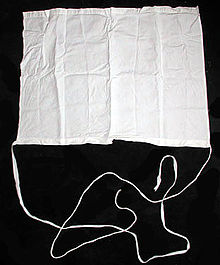 An amice | |
| Type | Liturgical vestment |
|---|---|
The amice is a liturgical vestment used mainly in the Roman Catholic church, Western Orthodox church, Lutheran church, some Anglican, Armenian and Polish National Catholic churches.
 An amice | |
| Type | Liturgical vestment |
|---|---|
The amice is a liturgical vestment used mainly in the Roman Catholic church, Western Orthodox church, Lutheran church, some Anglican, Armenian and Polish National Catholic churches.
The amice consists of a white cloth connected to two long ribbon-like attachments by which it is fastened. The garment is draped over the shoulders with the ribbons crossed over the chest, brought around to the back, and then brought forward again to be tied in front around the waist. The results can vary from being tight around the neck to leaving a deep v-neck opening. Before the liturgical reforms of 1972, its use was mandatory for all Roman Catholic masses, but it is only required today if the alb does not cover the priest's ordinary clothing. Many priests choose to wear the amice for reasons of tradition or to prevent damage to their other vestments due to perspiration.
Certain mendicant orders, such as the Dominicans and Franciscans, and some other orders with hooded habits, often donned the amice over the raised hood. The priest, or minister, then fastened the ribbons – crossed at the chest – behind his chest. The alb was donned over the hood and amice, and fastened. The hood/amice could then be retracted neatly around the collar.
In several Mediaeval uses, such as the Sarum Rite, the amice bore a broad stiff band of brocade or other decoration, giving the impression of a high collar. These were called apparelled amices. This practice was abandoned at Rome at about the end of the 15th century, [1] but continued in other parts of Europe until much later. By 1907, however, the practice was no longer tolerated in Roman Catholic liturgy, but still exists within many Anglican communities and in the Lutheran Church of Sweden. [2] [3]
This collar-like amice spread to the Armenian Church where is retained as a normal part of the priestly vestments among the Armenian Orthodox.
While donning the amice, the priest first drapes the amice over his head (as with a hood), then lowers it to his neck, tying it around his torso. During this action he prays a short prayer:
"Impone, Domine, capiti meo galeam salutis, ad expugnandos diabolicos incursus" (Place upon me, O Lord, the helmet of salvation, that I may overcome the assaults of the devil).
Subdeacon is a minor order or ministry for men in various branches of Christianity. The subdeacon has a specific liturgical role and is placed between the acolyte and the deacon in the order of precedence.
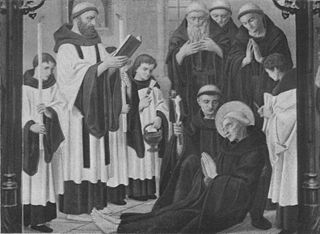
A surplice is a liturgical vestment of Western Christianity. The surplice is in the form of a tunic of white linen or cotton fabric, reaching to the knees, with wide or moderately wide sleeves.

The cassock or soutane is a Christian clerical clothing coat used by the clergy and male religious of the Oriental Orthodox Churches, Eastern Orthodox Church and the Catholic Church, in addition to some clergy in certain Protestant denominations such as Anglicans and Lutherans. "Ankle-length garment" is the literal meaning of the corresponding Latin term, vestis talaris. It is related to the habits traditionally worn by nuns, monks, and friars.
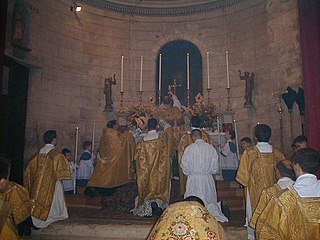
Vestments are liturgical garments and articles associated primarily with the Christian religion, especially by Eastern Churches, Catholics, Lutherans, and Anglicans. Many other groups also make use of liturgical garments; among the Reformed (Calvinist) Churches this was a point of controversy in the Protestant Reformation and sometimes since, in particular during the Anglican ritualist controversies in England in the 19th century.
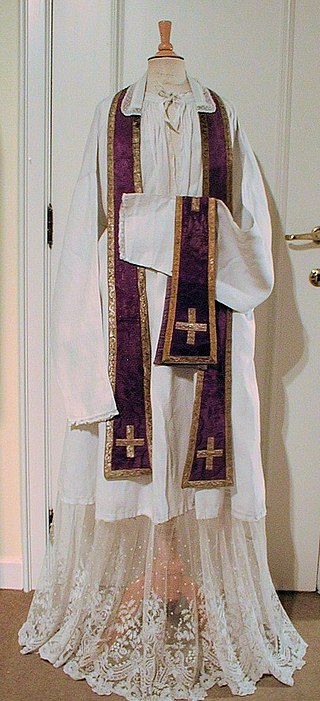
The stole is a liturgical vestment of various Christian denominations, which symbolizes priestly authority; in Protestant denominations which do not have priests but use stoles as a liturgical vestment, however, it symbolizes being a member of the ordained. It consists of a band of colored cloth, usually of silk, about seven and a half to nine feet long and three to four inches wide, whose ends may be straight or may broaden out in the shape of a spade or bell. The center of the stole is worn around the back of the neck and the two ends hang down parallel to each other in front, either attached to each other or hanging loose. The stole is almost always decorated in some way, usually with two crosses, or sometimes another significant religious design. It is often decorated with contrasting galloons and fringe is usually applied to the ends of the stole following Numbers 15:38–39. A piece of white linen or lace may be stitched onto the back of the collar as a sweat guard, which can be replaced more cheaply than the stole itself.

The chasuble is the outermost liturgical vestment worn by clergy for the celebration of the Eucharist in Western-tradition Christian churches that use full vestments, primarily in Roman Catholic, Anglican, and Lutheran churches. In the Eastern Orthodox Churches and in the Eastern Catholic Churches, the equivalent vestment is the phelonion.

The dalmatic is a long, wide-sleeved tunic, which serves as a liturgical vestment in the Catholic, Lutheran, Anglican, United Methodist, and some other churches. When used, it is the proper vestment of a deacon at Mass, Holy Communion or other services such as baptism or marriage held in the context of a Eucharistic service. Although infrequent, it may also be worn by bishops above the alb and below the chasuble, and is then referred to as pontifical dalmatic.
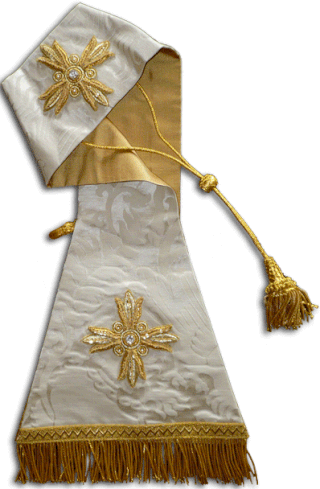
The maniple is a liturgical vestment used primarily within the Catholic Church, and occasionally used by some Anglo-Catholic and Lutheran clergy. It is an embroidered band of silk or similar fabric that is hung over the left arm. It is only used within the context of the Mass, and it is of the same liturgical colour as the other Mass vestments.

The cincture is a rope-like or ribbon-like article sometimes worn with certain Christian liturgical vestments, encircling the body around or above the waist. There are two types of cinctures: one is a rope-like narrow girdle or rope-like belt around the waist. The other type is a broad ribbon of cloth that runs around the waist and usually has a section that hangs down from the waist; this type is often called a "band cincture". One or both types are typically used in various Christian denominations. Both types are used in the various Western rites of the Catholic Church and provinces of the Anglican Communion. Consecrated members of the various Eastern rites, whether in the Catholic Church, or in the various Orthodox communions, sometimes wear a belt referred to as a zone.

The alb, one of the liturgical vestments of the Roman Catholic, Anglican, Lutheran, Methodist, Presbyterian, Reformed and Congregational churches, is an ample white garment coming down to the ankles and is usually girdled with a cincture. It is simply the long, white linen tunic used by the ancient Romans.

The cope is a liturgical vestment, more precisely a long mantle or cloak, open in front and fastened at the breast with a band or clasp. It may be of any liturgical colour.

The sticharion is a liturgical vestment of the Eastern Orthodox and Eastern Catholic Churches, roughly analogous in function to the alb of the Western Church. The sticharion is worn by all classes of ordained ministers in the Constantinopolitan Rite and comes in two forms: one worn by priests and one worn by deacons and other altar servers.
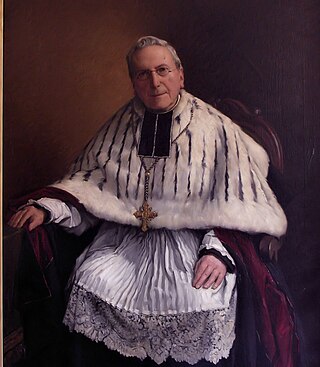
A rochet is a white vestment generally worn by a Roman Catholic or Anglican bishop in choir dress. It is unknown in the Eastern churches. The rochet in its Roman form is similar to a surplice, except that the sleeves are narrower. In its Anglican form it is a descendant of the traditional albs worn by deacons and priests. In the Roman Catholic tradition, the rochet comes below the knee and its sleeves and hem are sometimes made of lace; in the Anglican tradition, the rochet comes down almost to the hem of the cassock and its sleeves are gathered at the wrist.
Clerical clothing is non-liturgical clothing worn exclusively by clergy. It is distinct from vestments in that it is not reserved specifically for use in the liturgy. Practices vary: clerical clothing is sometimes worn under vestments, and sometimes as the everyday clothing or street wear of a priest, minister, or other clergy member. In some cases, it can be similar or identical to the habit of a monk or nun.

A clerical collar, clergy collar, or, informally, dog collar, is an item of Christian clerical clothing.

A pectoral cross or pectorale is a cross that is worn on the chest, usually suspended from the neck by a cord or chain. In ancient and medieval times pectoral crosses were worn by both clergy and laity, but by the end of the Middle Ages the pectoral cross came to be a special indicator of position worn by bishops. In the Roman Catholic Church, the wearing of a pectoral cross remains restricted to popes, cardinals, bishops and abbots. In Eastern Orthodox Church and Byzantine Catholic Churches that follow a Slavic Tradition, priests also wear pectoral crosses, while deacons and minor orders do not. The modern pectoral cross is relatively large, and is different from the small crosses worn on necklaces by many Christians. Most pectoral crosses are made of precious metals and some contain precious or semi-precious gems. Some contain a corpus like a crucifix while others use stylized designs and religious symbols.
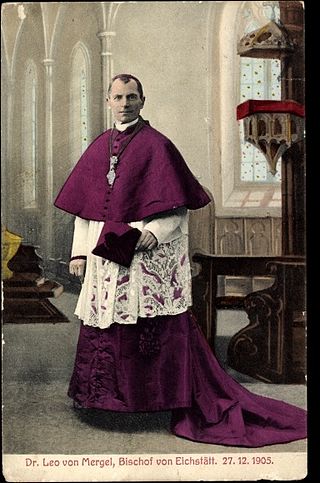
Choir dress is the traditional vesture of the clerics, seminarians and religious of Christian churches worn for public prayer and the administration of the sacraments except when celebrating or concelebrating the Eucharist. It differs from the vestments worn by the celebrants of the Eucharist, being normally made of fabrics such as wool, cotton or silk, as opposed to the fine brocades used in vestments. It may also be worn by lay assistants such as acolytes and choirs. It was abandoned by most of the Protestant churches that developed from the sixteenth-century Reformation.

The fanon is a vestment that around the 10th or 12th century became reserved for the pope alone and for use only during a pontifical Mass. The Cardinal Patriarch of Lisbon has the same privilege.
Pontifical vestments, also referred to as episcopal vestments or pontificals, are the liturgical vestments worn by bishops in the Catholic, Eastern Orthodox, Oriental Orthodox, Anglican, and some Lutheran churches, in addition to the usual priestly vestments for the celebration of the mass, other sacraments, sacramentals, and canonical hours. The pontifical vestments are only worn when celebrating or presiding over liturgical functions. As such, the garments should not be confused with choir dress, which are worn when attending liturgical functions but not celebrating or presiding.
The liturgical vestments of the Christian churches grew out of normal civil clothing, but the dress of church leaders began to be differentiated as early as the 4th century. By the end of the 13th century the forms used in the Roman Catholic and Eastern Orthodox churches had become established, while the Reformation led to changes in Protestant churches from the 16th century onward.